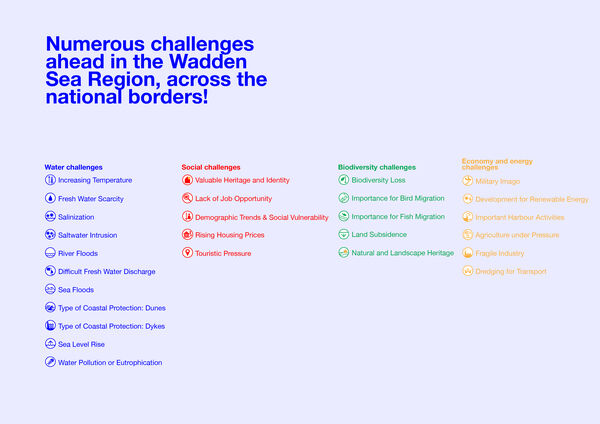In the Wadden Sea Region, the devastating consequences of climate change are an urgent reality. Can we reverse course in this UNESCO world heritage area while showing how to develop climate resilient communities and ignite a process of capacity building, planning and project implementation? Water as Leverage – Wadden Sea Region explores what the Water as Leverage approach could mean for the Wadden Sea, with local cases in the Netherlands, Germany, and Denmark.



The development of the Water as Leverage approach started from the observation that current water-related projects and mechanisms fall short of realising the long-term climate goals. Water is considered a separate sector, whereas reality shows otherwise. Water relates to many Sustainable Development Goals. Social conflicts can often be traced back to unfair access to high-quality water. The quality and quantity of our water supply has a direct link with the loss in biodiversity or agricultural value. The other way around, this makes water a binding element. Water can be a threat, but also a leverage.
In every sector — nature, water management, agriculture, residential development and so on – there are investments to deal with climate change. A resilient and rapid cross-sectoral approach is crucial for tackling challenges of climate adaptation. That is precisely what Water as Leverage brings in: a common workroom, in which the capacity of design is the integrator between different stakeholders and levels of innovation. It combines technical, social, and financial innovation. How can we come to solutions that are integrated, nature-based, climate-resilient, inclusive, replicable, and financially feasible? Water as Leverage for Resilient Cities Asia was the first program to turn this approach into action. With Water as Leverage – Wadden Sea, we do a first test of the program in Europe.
Water as Leverage – Wadden Sea Region
Why test the Water as Leverage approach in the Wadden Sea? As the largest tidal flat ecosystem in the world, it is a region with unique natural and cultural qualities. At the same time, many interdependent challenges jeopardise these. The challenges are related to climate change, such as salinization, drought, loss of wildlife, but also to the conservation of the built and natural heritage, touristic pressure, and the transition of the harbour areas. This makes it the ideal test-site for the implementation of the Water as Leverage program. How do we steer the inevitable transformation of the Wadden Sea to not only conserve but also strengthen the values that make the wealth of the region?
Seven local communities become part of the program: Texel, Terschelling and Harlingen in the Netherlands, Emden in Germany and Ribe, Esbjerg and Fanø in Denmark. Each of these cases cope with specific water-related problems and have their own methods and resources for tackling them. By engaging in the Water as Leverage program, they want to test how water could be used as a lever for sustainable and integrated transformation. Via a ‘Call for Action’ experienced water and climate experts, spatial designers, and other experts are invited to dive into these cases. These multidisciplinary teams will develop strategies and projects that transform the water system as well as its environment.
For Water as Leverage – Wadden Sea Region, Architecture Workroom Brussels operated as a neutral actor to help develop and bring together the different local cases. Through workshops, bilateral talks, and research we made a ‘Setting the Scene’-document, in preparation for the Call for Action. This document will guide the multidisciplinary teams through the history and challenges of the whole Wadden Sea Region, but it also shows the local challenges and questions of the separate cases.



